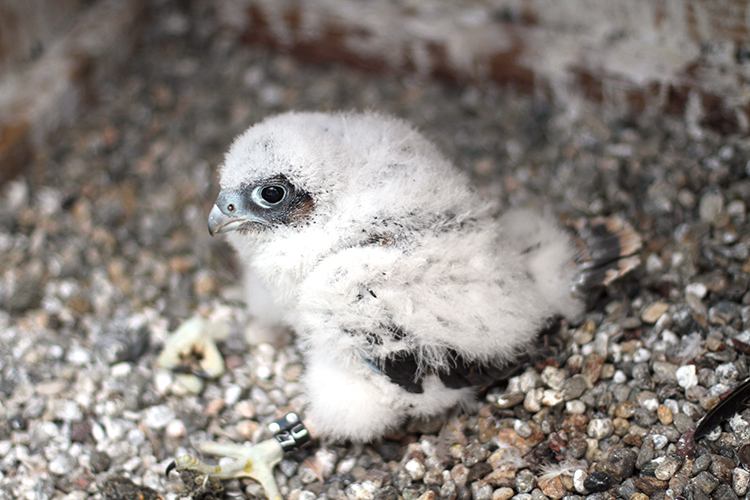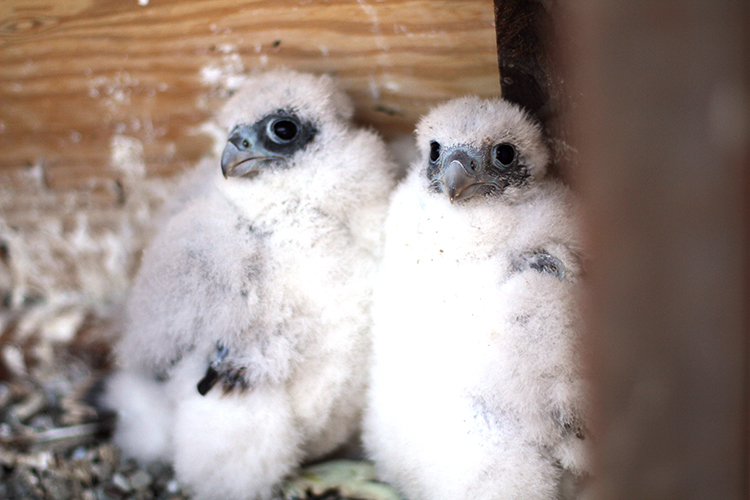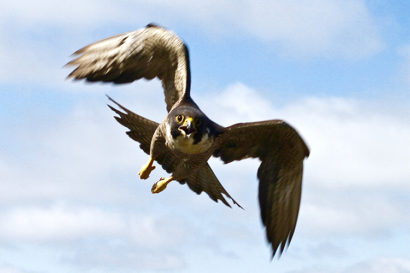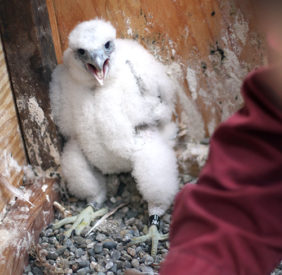Three peregrine falcon chicks banded, will fly in June
Researchers made their way to the second balcony of UC Berkeley's Campanile to put identifiers on the two males and one female, born about three weeks ago
May 18, 2018
Three peregrine falcon chicks — two males and one female — were banded by experts yesterday high up on UC Berkeley’s Campanile, where they hatched last month. The protective mother dive-bombed researchers as they fitted and secured the bands, and she landed occasionally on a ledge and light poles nearby. This is the second year in a row that the same peregrine couple has raised a family on the 307-foot tower.

One of the male peregrine chicks (Photo by Mary Malec)
Peregrine falcons are the fastest animal on the planet. They fly at speeds of 200 to 300 miles per hour and kill their prey — usually other birds — in mid-air. They are aerodynamic and have extraordinary eyesight. While humans can focus on one thing at a time, peregrines can focus on two — the thing they’re chasing and the thing they’re going past.
Berkeley News spoke with Glenn Stewart, a researcher with UC Santa Cruz’s Predatory Bird Research Group who banded the chicks with colleague Zeka Glucs, about how banding has helped researchers learn more about peregrine falcons.
Berkeley News: How do you know when chicks have hatched?
Glenn Stewart: The way it works with peregrines is, they don’t go home every day and eat dinner at the dining room table; they eat their food where they catch it. But when they have babies, they bring the food in to the nest area. So when the food started coming into the balcony on April 23, we knew the eggs had hatched. The key to us being able to band the babies is to know how old they are, so it’s crucial for us to have good observers on the ground every day who can watch the behavior of adults and know when they start bringing food to the nest area.
How old were the chicks when you banded them?
They were 24 days old, which is a perfect age. I want to be there when they’re 3 weeks and a couple days old, when their bodies are almost full grown — they go from 30 grams (about 1 ounce) to 1,000 grams (about 2.2 pounds) in just three weeks. I use a little tool to measure their tarsus (the ankle bone where the band is placed), which tells us what size band to put on.
The males usually take a size 6 and the females usually take a size 7. We get some in-betweeners and I have a simple solution for that: I just put the bigger band on them, so it’s comfortable for the bird. I don’t need to make up my mind whether it’s a male or female; I just need to put the right band on them.
What do you learn by banding birds?
Bird banding has been a formal program through the U.S. Fish and Wildlife Service for over 100 years. We learn about how long they live and where they go. With peregrines, though, they come to the same places year after year to nest, so I guarantee you they’ll nest at the Campanile again next year. What’s going to be interesting down the line is to see if one of the birds that we banded at this nest area comes back and nests there. It could happen. So we get some information about movements between their natal site and their nesting site. They start to nest when they’re 2, 3, 4 years old.
What information is on the bands?
I put two bands on, one on each leg. One leg has a black-and-white band with an alphanumeric code that is readable through a spotting scope — it has a letter and a couple numbers on it called a visual identification (VID). [The Campanile female’s VID is 11/AM and the two males’ are U/46 and U/27.] The other is an aluminum band with a unique nine-digit number and the phone number and email of the banding laboratory. Typically, this information is only reported when the bird is found dead or has been captured.
How can someone report a banded bird?
They can report it to the U.S. Fish and Wildlife Service Bird Banding Laboratory. If someone sees a VID through a scope and reports it to the bird banding lab, I’ll get an email that says U/25 was last seen in Baja, Mexico. And I go, “Holy cow, I banded that bird years ago in the Santa Cruz mountains. That gives us quite a bit of information: She’s 3 years old, she traveled to Mexico and she’s coming back to Santa Cruz to breed.

One of the male chicks (left) and the female huddle together. (Photo by Mary Malec)
Like last year, a group of volunteers organized by Mary Malec, a volunteer raptor nest monitor for the East Bay Regional Park District, will watch for the chicks’ first flight to make sure they land safely. Fledge is expected on day 40 for males and day 42 for females. They will begin “fledgewatch” on June 1 and will continue to monitor them throughout the week until all three fledglings are flying and landing well.
To help name the chicks, leave a comment on UC Berkeley’s Facebook page.
Learn more about the Campanile’s peregrine falcons on Berkeley News. Check back in June for updates on fledgewatch.

